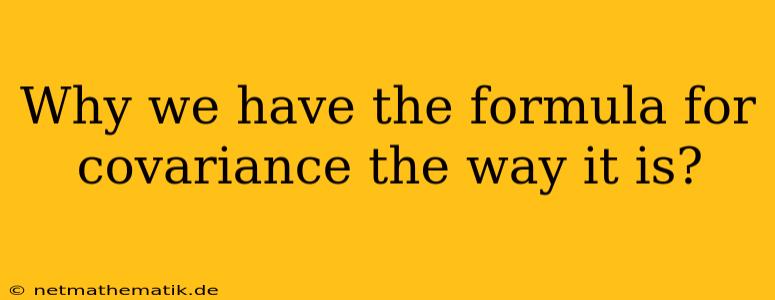In the realm of statistics, covariance plays a crucial role in understanding the relationship between two random variables. It measures how much these variables change together, indicating whether they tend to move in the same direction (positive covariance) or opposite directions (negative covariance). But why is the formula for covariance defined the way it is? This article will delve into the rationale behind the formula, exploring its mathematical foundation and its connection to the concept of correlation.
Understanding the Formula: A Deeper Dive
The formula for covariance between two random variables, X and Y, is given by:
Cov(X, Y) = E[(X - E[X])(Y - E[Y])]
Where:
- E[X] and E[Y] represent the expected values (means) of X and Y, respectively.
- E[(X - E[X])(Y - E[Y])] represents the expected value of the product of the deviations of X and Y from their respective means.
At first glance, this formula might seem a bit convoluted. However, it's rooted in a clear and logical concept: measuring the average product of deviations. To understand this, let's break down the formula's components:
1. Deviations from the Mean:
The terms (X - E[X]) and (Y - E[Y]) represent the deviations of individual values of X and Y from their respective means. These deviations tell us how much each individual value differs from the average.
2. Product of Deviations:
The product of these deviations, (X - E[X])(Y - E[Y]), captures the joint behavior of X and Y. When both deviations have the same sign (both positive or both negative), their product will be positive, indicating that X and Y tend to move in the same direction. Conversely, if the deviations have opposite signs, the product will be negative, indicating that X and Y tend to move in opposite directions.
3. Expected Value:
The expected value, E[(X - E[X])(Y - E[Y])], takes the average of the product of deviations across all possible values of X and Y. This averaging process gives us a summary measure of the overall tendency of X and Y to move together.
Connection to Correlation: Normalizing the Covariance
While covariance provides valuable information about the relationship between variables, it's often difficult to interpret due to its dependence on the scales of X and Y. To overcome this limitation, we introduce the concept of correlation, which normalizes covariance by dividing it by the product of the standard deviations of X and Y:
Cor(X, Y) = Cov(X, Y) / (SD(X) * SD(Y))
Correlation, denoted by Cor(X, Y), ranges from -1 to 1, making it easier to interpret the strength and direction of the relationship. A correlation of 1 indicates a perfect positive linear relationship, a correlation of -1 indicates a perfect negative linear relationship, and a correlation of 0 suggests no linear relationship.
Why This Formula Works: A Geometrical Perspective
To gain a deeper understanding of why the formula for covariance is effective, consider a scatter plot of two variables X and Y. The mean of X, E[X], and the mean of Y, E[Y], represent the center of the data cloud. The covariance captures the tendency of the points to cluster around the mean.
- Positive Covariance: If the points tend to cluster along a line with a positive slope (moving upwards from left to right), then the deviations from the mean will tend to have the same sign, resulting in a positive covariance.
- Negative Covariance: If the points tend to cluster along a line with a negative slope (moving downwards from left to right), then the deviations from the mean will tend to have opposite signs, resulting in a negative covariance.
- Zero Covariance: If the points are scattered randomly with no clear pattern, the deviations will be independent, leading to a covariance close to zero.
The Importance of Covariance in Statistics
The concept of covariance has wide-ranging applications in statistics and related fields:
- Regression Analysis: Covariance is a key ingredient in linear regression, where it helps determine the slope of the regression line, representing the relationship between the predictor and response variables.
- Portfolio Management: In finance, covariance is used to assess the risk and return of investment portfolios, helping investors diversify their holdings by choosing assets that are not highly correlated.
- Principal Component Analysis (PCA): PCA, a dimensionality reduction technique, relies on covariance to identify the directions of greatest variance in a dataset, enabling data compression and visualization.
- Time Series Analysis: In analyzing time series data, covariance is used to measure the autocorrelation of a series, revealing patterns and dependencies across time periods.
Conclusion: Why the Formula for Covariance is Vital
The formula for covariance, while seemingly complex, provides a robust and reliable way to quantify the relationship between two random variables. It captures the average product of deviations from their means, offering a measure of how much these variables change together. By understanding the mathematical basis of the formula and its connection to correlation, we gain valuable insights into the nature of relationships in data, enabling us to build effective statistical models and make informed decisions. The use of covariance extends across diverse areas of statistics, making it a fundamental concept for anyone working with data analysis and modeling.
